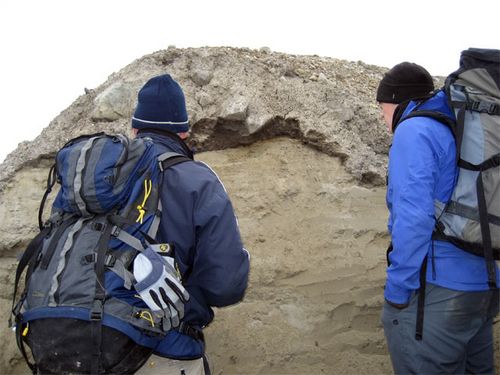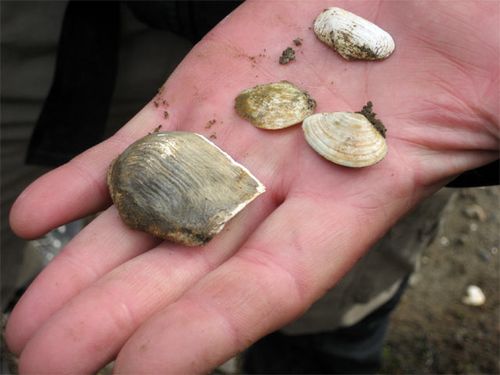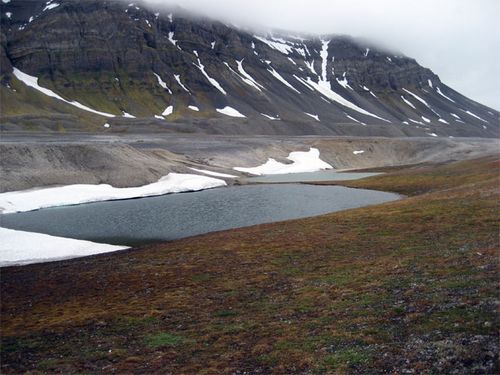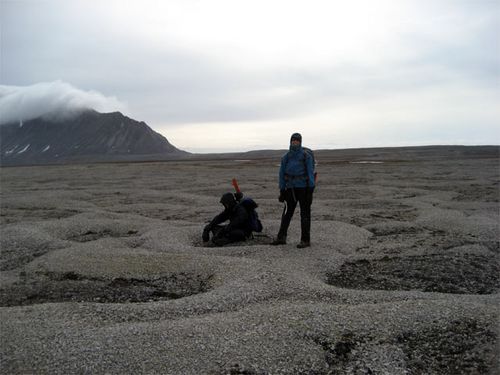Remember the discussion in the last journal entry about the wind up here? Well, it's still here and it felt as if it was blowing against us no matter which direction we hiked! Although we were all dressed for the wind, after a while it can wear a person down hiking against it in the cold air. When the cold wind hits uncovered skin, it can be chilling experience that can lead to frostbite and other related cold weather effects on humans. The wind chill effect combines air temperature and wind speed to produce a temperature value related to the rate of heat loss of uncovered skin. In order to thwart the impact of the wind chill we all dressed in multiple layers with Gore-Tex on the surface, and protected our faces with balaclavas, neck gators, hats. Even with all this protection we arrived back at the station totally windblown and with rosy cheeks after a day with a wind chill of -6°C. What were we doing outside in wind like this? First of all, field work does not stop for the weather, but we just need to be more selective on the activities we select for the day. Working on the lakes in the boats was not an option, and we had not gone on a "field trip" to the north end of the valley since getting here making the field trip the option for the day. Field trips are an important part of field work since they help to connect the study area to the entire region, and force the participants to debate the features they are looking at. Al and Mike are terrific at asking questions and probing for ideas, and at the end of the day the students walked away with even better understanding of their study location.


The north end of the valley is the drainage outlet for Lake Linne, and thousands of years ago it was totally open to the fjord. When the last glacier retreated back in the valley over 10,000 years ago, the land in the north end of the lake began to rise, and eventually closed up the glacial valley to the fjord, leaving only the Linne River to connect Lake Linne to the fjord. The entire north end of the valley has an irregular topography of till ridges with a boulder pavement over sand. Over 10,000 years ago when sea level was relatively high because of the weight of the glacier, sediments accumulated in front of the glacier. This glacial till began to erode, depositing the finer material further away from the till margin moving the cobbles on top of the sand. We saw this layering as a muddy coarse matrix on top of layers and layers of sand and mud. Found within the sands were boreal mollusks similar to what is found today in these waters. Looking closely at these mollusks differences in their shells can be seen such as thicknesses in their banding and their hinge lines. These differences along with carbon-14 dating, can inform us about the temperature of the past 10,000 yrs. Mike collected a number of these shells to take back to his college for further analysis and we are curious about what information they will hold.

We continued our "field trip" to the northeast side of the valley and there we saw lakes that are defined as karst lakes. These curious lakes defy our basic understanding of the tundra and the permafrost because technically they should not be here. Further thought about the carbonate bedrock on this side of the valley provided us with a plausible answer to their origin. It is thought that these lakes are sitting over rock material that has dissolved over time, thus leaving a depression. The observation that supports this model is that the lakes are lined up in chains parallel to the carbonate ridge to the east. Our last stop was a visit to some awesome limestone sorted circles. The design of these circles was so explicit that it beckoned a bit of conjecture about their formation. We left these circles with more questions than answers!


Windblown and cold, it was a successful day for all!
Thanks to all who participate in the Live from IPY event - we enjoyed talking to you!


Comments